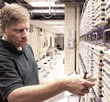Dialing up a new system

The Rolm CBX 9000 telephone switches at NASA's Goddard Space Flight Center in Greenbelt, Md., had been humming along since 1986 ? a long life for such equipment.
The Rolm CBX 9000 telephone switches at NASA's Goddard Space Flight Center in Greenbelt, Md., had been humming along since 1986 ? a long life for such equipment."The maintenance was becoming a little costly," said Mary Ellen Shoe, assistant branch head and customer service manager at Goddard. "We were getting to the point where the parts were not always going to be there for us."When NASA replaced the switches with new asynchronous transfer mode-based equipment from Siemens AG of Munich, Germany, it enjoyed more than just better reliability, however. The agency now can connect two locations 180 miles apart without paying long-distance charges. The network also allows NASA to cut back on administrative services and provides a voice over Internet Protocol capability that makes videoconferencing much easier. Goddard replaced the equipment from Rolm, which had become part of IBM Corp. and then part of Siemens, with a new digital phone system from Siemens. Fifteen Rolm switches gave way to six Hicom 300 communications servers on an asynchronous transfer mode fiber network.Siemens, an electronics and communications giant employing more than 450,000 people in 190 countries, had earnings of about $2 billion on revenue of about $86 billion in 2001.Over the 2001 Labor Day weekend, about 10,000 phone sets were replaced with Siemens optiset E handsets. All phone numbers remained the same. Over the Veterans Day weekend about two months later, two Hicom 300 servers replaced four other Rolm switches at NASA's Wallops Island Flight Facility, 180 miles south at Chincoteague, Va."We were having the same problems" as Goddard, said Carl Johnson, head of Wallops' Information Service and Advanced Technology Branch. "We couldn't extend digital features to all locations."The ATM link has eliminated toll charges between the two facilities. Greenbelt houses all the system management functions and directories.Although the Hicom servers are part of Siemens' Internet Protocol product line, "there is no need to implement on IP when a [digital] infrastructure already is in place," as it was at the Goddard and Wallops campuses, Siemens sales manager Colleen Howard said.Via time-division multiplexing, the switches push voice traffic over the network in 64-Kbps channels. "It would have been expensive to upgrade the [copper phone] network for voice over IP," Siemens engineer Diane Evans said.The ATM link between Goddard and Wallops was a strong incentive to move to the digital phone system. Besides eliminating toll charges between facilities, it consolidated administrative services, including telephone operators."We had an operator support problem and had to cut back at Wallops," Shoe said. "I don't know if it would have even been possible to connect the old switches. I suspect not." She said there have been no complaints about the consolidated service.Johnson said he prefers the new setup. "With one call to an 800 number, I can take care of all my business," whether it is at Goddard or Wallops, he said.The modular phones have caller ID and snap-in modules for analog voice and integrated services digital network applications. "You don't have to make a permanent commitment to an application," Evans said.But the primary advantage of the new system has turned out to be convenient desktop videoconferencing via primary-rate ISDN."NASA has become a fairly large user of videoconferencing," Evans said. The Hicom system eliminated the need for a separate ISDN switch for video and for many three-hour drives between Greenbelt and Wallops Island.Although the NASA campuses are not using voice over IP as their primary service, Wallops is trying it on a few test beds, Johnson said. "We're a research range, so we constantly have projects coming on or off the campus," often in mobile trailers, he said. They all need voice and data connections.His branch also is extending IP service for both computers and telephones to some projects in remote areas through a laser connection. The laser provisioning also is under consideration for fast temporary service in case of an interruption from, say, a cut cable.The key to a successful switch from one phone system to another is contractor cooperation, Shoe and Johnson both said. The vendor must know the customer's needs, and the customer must know the vendor's capabilities."Siemens was willing to do the up-front work," Johnson said. "But the real key was that we worked together. We asked a lot of questions. We learned their technology and their product line."


Lee Dumais, Siemens customer service engineer, works on the main distribution frame for NASA Goddard Space Flight Center's historic voice-over-ATM network.
NEXT STORY: On the edge: News briefs

